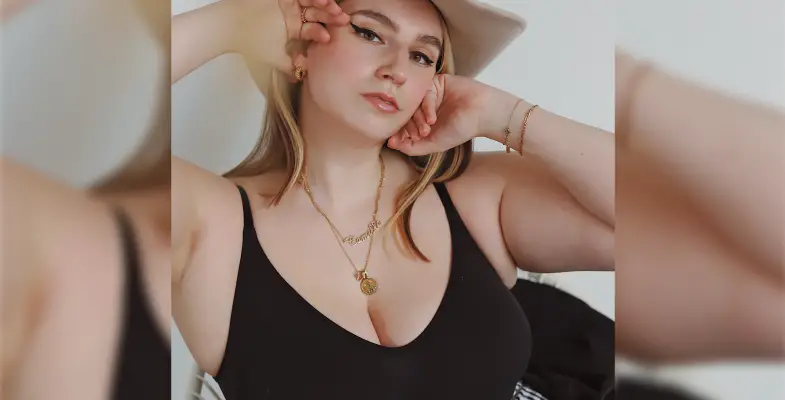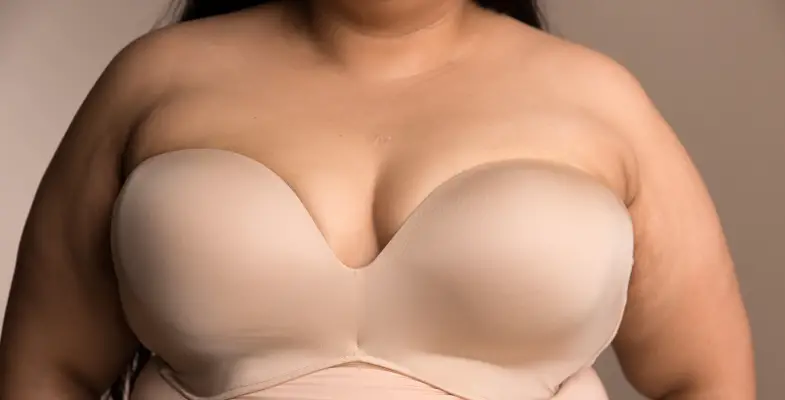It’s amazing how much havoc the term full-figured continues to stir in society. With so many mixed, conflicting, and half-truth views, let’s get to the bottom of what is considered full-figured.
Full figured has very little to do with measurements, body dimensions, weight implications, and a lot to do with the fashion industry’s use of the term on the one hand and societal perception on the other.
The dictionary meaning of full-figured is fat or plump. But if you thought that a word defined in the dictionary in no uncertain terms would be understood to mean what is said, you will be in for a surprise. There are several perspectives and takes on what full-figured “really means,” and sadly, that varies from person to person.
A greater majority of those who try to define the term approach it from a comparative vantage point. They compare what full-figured means vis-a-vis ‘being curvy’ or ‘being plus size’ or “being unhealthy’ and the list goes on and on. The comparisons drawn offer useful pointers to the conversation. However, as with any strongly emotive societal issue – there is hardly any consensus on the same. Somehow nearly everyone is more content on maintaining their version of what full-figured is instead of striving for a more unified consensual meaning.
Body measurements have been pivotal to fashion and the societal underpinnings of what is beautiful and what is not. Especially for women (for some biased reason, men are not always caught in the crossfires as women), being thicker around the hip area, buttocks, and the bust region is greatly celebrated and idolized as ‘sexy and beautiful.’ The converse is also true; if you are straight and flat, you are viewed to be unflattering, too ‘boxy,’ and thus unappealing. Being thick around your waist, arms and legs is completely frowned upon and even ridiculed in many societies.
Many women find themselves at the nexus of these two polarized views. Some have wider hips, buttocks, and also waistlines. However, they are generally not deemed beautiful and, in most instances, are described as fat, obese, or at times morbidly obese. From the above, the reasoned observation of women’s body measurements evidently reveals that thickness in the right places matters. However, what seems to be of greater significance to most people is the size of your waist! It is on this small nitty-gritty measurement that society’s approval or disapproval rises and falls.
The popularly praised body dimensions acclaimed to be most flattering and endearing are those of hourglass silhouettes in today’s world. For many decades, this was the preferred body type before pear shapes were added to this list. And this was not without careful consideration by those who determined the face, style, and size of beauty on the runways and mainstream media. In both these silhouettes, there is a drastic difference between their stick-thin waistlines and wider hips. The only minute difference was that hourglass figures also had voluptuous busts, and pear shapes had smaller busts. The distinction between breast size, hip size, and waist size and their effect on an individual’s upper and lower body proportions forms the backdrop from which most of these comparative articles are written.
Why Full-figured is not Plus Size, or is it?
This is a common comparison that writers use to explain what full-figured really means. They almost always start by refuting that full-figured has any connotation with plus size. The thrust of their argument is that you can never fall within both categories at the same time. A full-figured person CANNOT be plus-size, and a plus-size woman CANNOT be deemed full-figured.
In this instance, full-figured is used to refer to thinner ladies who have wider busts and hips. On the other hand, plus size refers to chubby ladies (fat or plump) even though they have wider busts and hips than their waistlines. Ironically, as mentioned earlier, what matters is your waist size and not necessarily the prominence of other features.
There’s another school of thought comprising those who contend that thicker ladies, those between a size 14 and 18, can be full-figured. These slightly bigger women, who essentially are regarded in the world of fashion as plus size, tend to be more voluptuous around their hips, butts, and busts in comparison to their ‘slightly wide ‘ waistlines. They, therefore, assert that a substantial portion of plus-size women can and actually are full-figured.
Hopefully, that wasn’t puzzling. There is more that commentators and writers have to say while comparing full-figured to curvy women.
Does Full Figured mean Curvy?
A majority of those who have delved into the matter concludes that full-figured does not mean curvy, but curvy women can be full-figured in some instances.
In this instance, full-figured refers to thinner women who have fuller breasts, while the term curvy is generally used to refer to women with distinct curves – those who are thick in the ‘right’ areas – but are small-chested. The overriding factor, in this case, is your cup size as opposed to your waist size. However, waist size remains a notable factor because it helps define your upper and lower body proportions.
This definition of full-figured is popular in the bra fashion industry. Women who have larger cups and smaller band sizes are considered full-figured. In contrast, women with larger cups and bigger band sizes are not. Your bust-to-band ratio determines whether you are full-figured or simply curvy. A commentator once wrote, “being full-figured means that you are small everywhere except around the bust region and perhaps your hip and buttock region.” Whereas being curvy is loosely used to refer to thicker women throughout their frame but have visible curves. This broad definition of a curvy woman can fit anything from plus size to super-sized woman.
In the bra industry, full-figured is commonly used to mean that you have a D cup size or larger. If this were the only qualification, several women would perfectly fit the full-figured definition. However, there’s an additional criterion, band sizes. Apparently, your bust should be bigger than your band size, giving a ‘distinctly voluptuous upper body proportion.
At this juncture, let’s highlight the similarities and disparities from the above comparisons.
| Full-figured | Curvy | Plus Size |
| Small waist | Either small or large waistline | Wider waist |
| Big bra cups | Either small or big cups | Big cups |
| Small hips and buttocks (in most cases) | Large hips and buttocks | Large hips and buttocks |
| Key feature: Large breasts in comparison to her body proportions | Key feature: Very defined curves, especially on her lower body portions. | Key feature: Large and thick throughout their body frames. |
Of course, there are mild variations to these specifications as a sizable portion of women lie at the intersection of these three body types. These cases may be more complex as the ladies may exhibit some characters of both of any two body types. A case-by-case analysis is more prudent than making sweeping general statements on who fits where.
However, the above-tabulated representation represents the pervasive societal notions of what full figure, curvy, and plus-size mean.
Does Full Figured Mean Not Healthy?
Other than the contested debate on body measurements and upper and lower body proportions, a popular question about full-figured women is whether they are healthy. Typically, the common (though false) belief is that full-figured women are not healthy. This belief is quite popular because many are misguided by the belief that ‘full’ connotes being overly plump and overweight. This cannot be further from the truth. Full-figured women are essentially thinner in body size. On the contrary, the term ‘full’ is about breast size, not general weight.
Therefore, it is more accurate to conclude that a majority of full-figured women are indeed healthy women. However, this conclusion’s veracity also depends on a case-by-case analysis of the lifestyle choices of each of the individuals. Simply because the rest of your body does not stack up a lot of fat compared to your bust area does not mean you are healthy. You may look the part but are you healthy? As they say, appearances can be deceiving.
Full-figured women who lead active, vibrant lives and make smart, healthy lifestyle choices are certain to be healthy, strong, flexible, and less prone to diseases or illnesses. These women may not necessarily be stick-thin but have great body physique and muscle definition.
Is being Full-figured All about Body Measurements?
Until this point, as do most discussions around the topic, body measurements are the predominant factor in classifying where each body silhouette fits in the broad spectrum of body types. However, is that all when it comes to being full-figured? Is it simply a game of numbers, and what the measuring tape or weighing scale reads?
The answer is twofold, in a technical sense, yes. When it comes to the world of fashion, the term full figure has everything to do with body measurements. Categorizing body silhouettes solely based on their measurements is crucial for fashion designers to create clothes that fit, accentuate, flatter and define various body sizes. In the immediate case, no other consideration is of overwhelming importance, neither is there a need for any to be.
However, in a more general sense, the term has a lot more to do with the general character and societal perception towards an individual than their measurements. This humane perspective of what full-figured is appreciated that full-figured does not refer to lifeless bodies moving through lives’ motions. These bodies have names, they have character, and they have personalities that are well-deserving of recognition. Especially with the current societal notions on women and beauty, this perspective is key in shaping our views and attitudes.
Being one of the more coveted body silhouettes, many women have tried to achieve this look by all means. Some have undergone surgery to perk up and size up their boobs while trimming down their tummies. Others have opted for more natural remedies such as creams and ointments and some targeted exercises. No matter the means, understanding that having your ideal body frame is a fraction of the quest for internal peace and satisfaction. Women should also focus on the other bits of life that matter – friendships, family, self-care, self-actualization, emotional development, career advancement, giving and sharing, and the like.
Size is just but a number and shouldn’t be ranked superior to the person’s humanity in question. Having people engage without the inclinations to judge or boxing someone into a particular body type category and treating them differently from others will help make the world a better place. More so, for women who are constantly under pressure to conform to the prevalent and, at most times, unrealistic and exaggerated views on what their bodies should look like. It will encourage body positivity and a focus on what matters most – the person – their heart, their gift, their capabilities, abilities, achievements, ambitions, fears, and interests.
What Full-figured is…
Last but not least– full-figured is beautiful. Just like any other body type is beautiful. Beauty is skin deep, not size small. Celebrating these women allows us to see past the overhyped body dimensions and the erroneous assumptions and really get to acknowledge them for simply being women. There is never a one-size-fits-all beauty standard, and today’s surging growth of the plus-size industry is a living testament to that.
Beauty is an all size fits affair.
Conclusion
Considered one of the more desirable body types among women, full-figured silhouettes stand out because of their larger upper body proportions. They typically have larger cups compared to their bandwidths, giving them the appearance of fuller breast size. Hopefully, the confusion is long gone, and you are now better placed to appreciate the different viewpoints that various ‘players’ have on what full-figured is and what it is not. Cheers!



